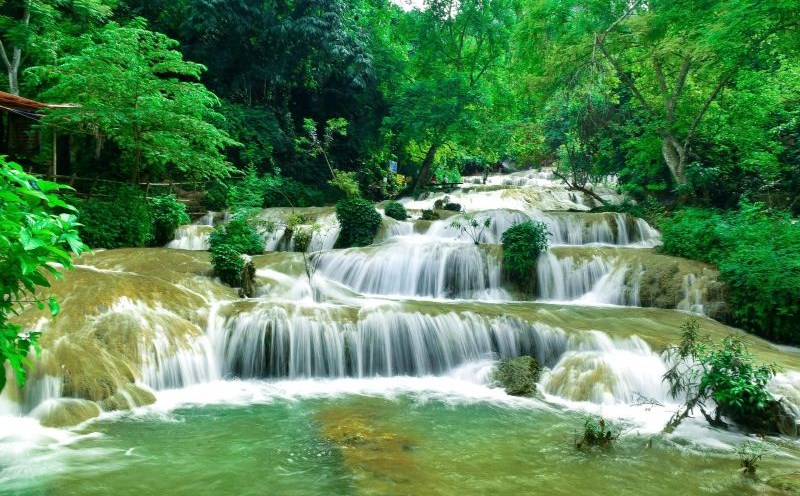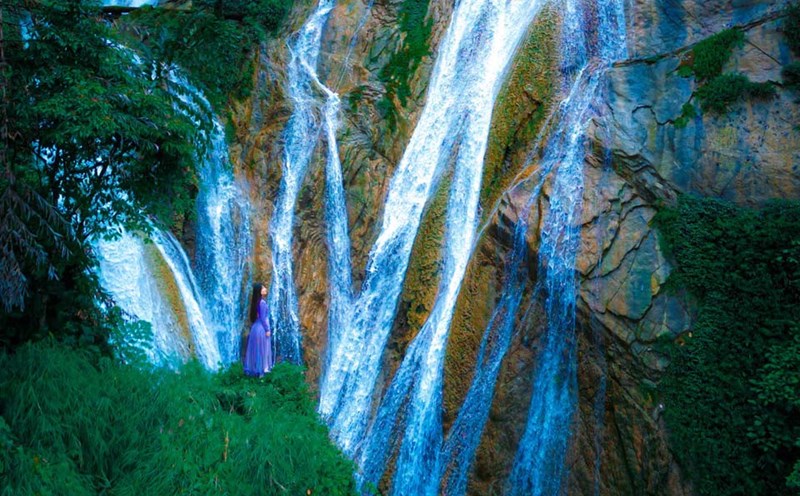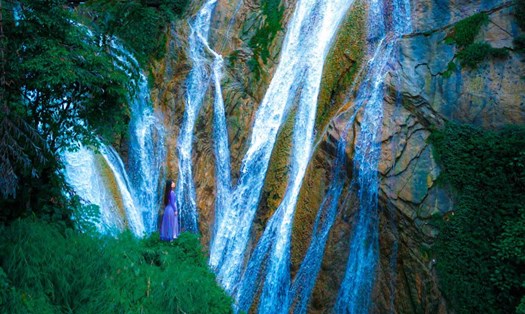From the ancient bou forest...
On the first day of August, the sun was shining, going against the winding slope, crossing the elevated road under construction, we began our journey to explore Mu waterfall and Bai Bui green grassland, two "pearls" on the roof of Muong Vang.
Of the four Muong (Bi, Vang, Thang, Dong), Vang is the second largest area of the old Hoa Binh province, now part of Phu Tho province. Ngoc Son commune is the roof of Muong Vang, established on the basis of merging Ngoc Lau, Ngoc Son and Tu Do communes (old Lac Son district), the entire commune is located in Ngoc Son - Ngo Luong Nature Reserve.
Returning to Ngoc Son this time, it is easy to see that Muong villages still retain their identity, the ironwood stilt houses, the roofs are covered with palm trees, the simple lifestyle and the custom of "throwing off the hat" to greet each other are still intact. Our first stop was Bai Bui.
Bai Bui is located in Khop hamlet, where there are 67 ancient tlau (chau) trees hundreds of years old growing on lush green lawns. Previously, this was the "asset" of the Muong people in Khoi hamlet, associated with the memories of herding buffaloes and cutting grass. In the past ten years, Bai Bui has become a famous stop. Many trees are so big that two adults cannot hug them. The tree trunks are marked with the layer of loose geology.
"It is very difficult to determine the age of this flood forest. Since I was a child, the trees have grown as large as they are now. The oldest man in the village, now 97 years old, also said that when he gave birth, the flood forest was available, said Mr. Bui Van Huan, the elderly man in Khoi hamlet.
To serve visitors to visit and experience, Bai Bui has a restaurant and homestay for visitors to stay and enjoy the fresh space in the steppe.
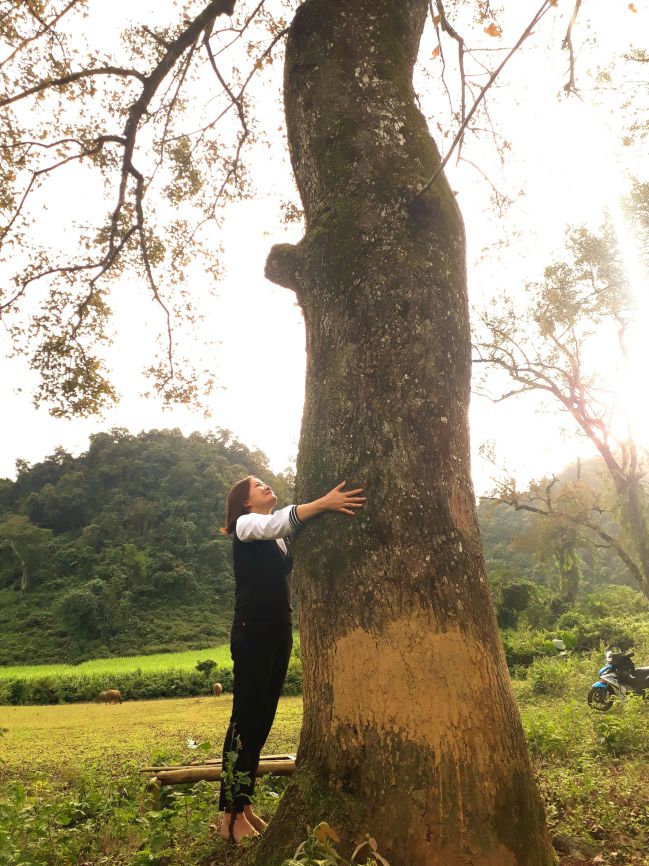
...To the white silk strip in the middle of the great crowd
Leaving Bai Bui, we continued our journey to explore the scenic spot of Mu Waterfall. The distance is nearly 10km, traveling by car only takes more than 20 minutes.
Previously, the only road leading to Tu Do land, where the famous waterfall is located, was quite difficult. Now, the road has been expanded and hardened, creating more favorable conditions for many tourists. After crossing the winding roads, going up and down, Mu Waterfall appears like a soft white silk strip in the middle of a vast forest with a side of mountains overlapping with mountains, and a side of terraced fields with hidden stilt houses.
Mu Waterfall is located in Mu Khuong hamlet. Upstream is a cool stream flowing through Muong village. This season, the abundant water source causes the waterfall to splash white foam, echoing in the mountains and forests. At the foot of the waterfall are layers of relaxing water, leading to a large, blue lake, formed over hundreds of years of wear and tear of the flow. This is a favorite place for many tourists, comfortably swimming, having fun, and dispelling the summer heat.
In recent years, the number of visitors to Mu Waterfall has increased, leading to the strong development of community tourism. Ms. Quach Thi Hanh, owner of Thu Hanh homestay in Mu Khuong hamlet, shared: Realizing the great demand for resorts and experiences of tourists when coming to Mu waterfall, my family opened a homestay. There are often many customers on weekends. In addition to bathing in waterfalls, they can also enjoy dishes with rich mountain and forest flavors such as hill chicken, mountain snails, stone crab, local pigs... All are prepared by my family to help visitors fully feel the flavors of the homeland and the love of the highlands".
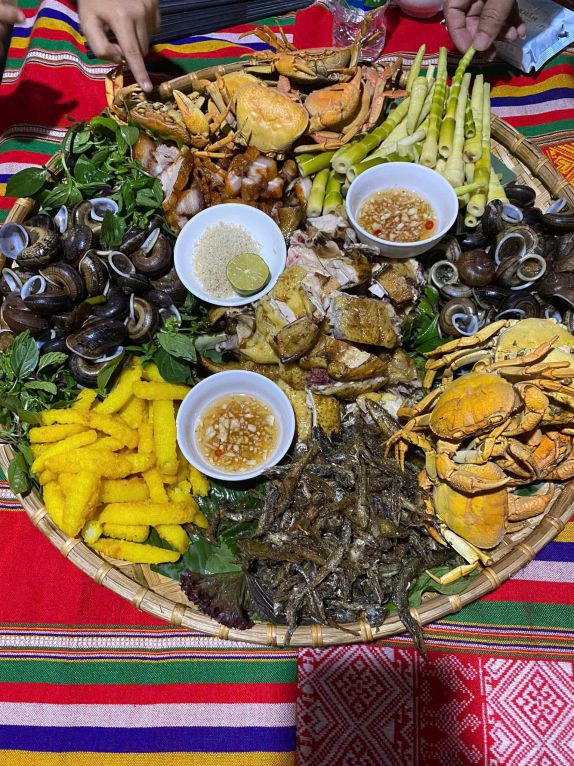
Mr. Bui Van Chinh, a neighbor, said: Developing tourism helps people become more aware of preserving cultural identity. Many new homestays have been built but still retain traditional architecture. Art troupes maintain activities and perform to serve guests. After bathing in the waterfall, visitors can walk around the village, learn about the life and customs of the Muong people".
Ms. Nguyen Thu Trang, a tourist from Hanoi, said, I was impressed by the majestic scenery of Mu Waterfall and the cool climate of Muong village. The atmosphere here is clear, waking up in the morning only hearing the sound of streams and birds, it feels like life is slowing down".
According to statistics from the People's Committee of Ngoc Son commune, in Tu Do commune (old), there are currently over 80% of households still living in stilt houses. The space of the poetic Muong stilt house nestled next to the mountain and stream brings a feeling of relaxation and complete harmony with nature.
Mr. Vu Quoc Tam, Chairman of Ngoc Son Commune People's Committee, said: Tourism development is the main direction of Ngoc Son Commune, focusing on community tourism and experiential tourism in Ngoc Son - Ngo Luong Nature Reserve. In addition to the primeval forest, Mu Waterfall and Bai Bui, Ngoc Son also has great potential to become an outstanding destination thanks to its unique Muong cultural identity, authentic stilt houses, fresh climate all year round and attractive cuisine.
Ngoc Son - Ngo Luong Nature Reserve is the corridor connecting Cuc Phuong National Park with Pu Luong Nature Reserve (Thanh Hoa). This is a typical limestone forest ecosystem, preserving the rare genetic resources of many endemic animals and plants, playing an important role in protecting upstream, protecting water resources, and regulating the climate. Coming to the roof of Muong Vang, there will be interesting experiences, helping visitors immerse themselves in the nature and unique cultural identity of the Muong villages.

